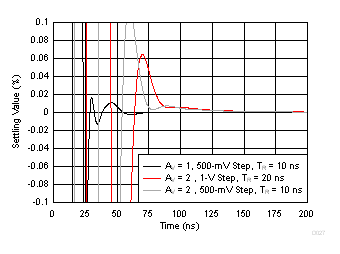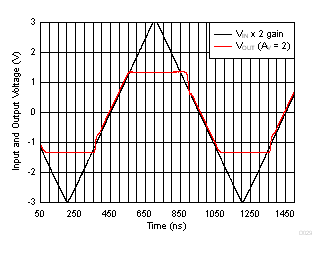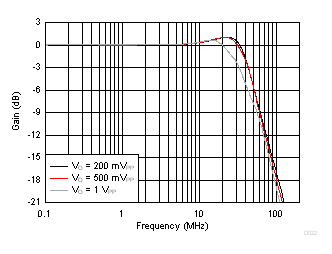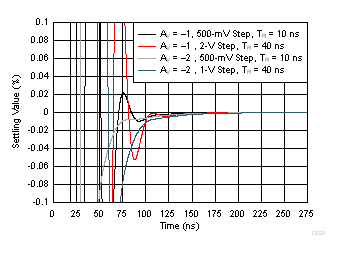ZHCSGP3D September 2017 – December 2018 OPA2837 , OPA837
PRODUCTION DATA.
- 1 特性
- 2 应用
- 3 说明
- 4 修订历史记录
- 5 Pin Configuration and Functions
-
6 Specifications
- 6.1 Absolute Maximum Ratings
- 6.2 ESD Ratings
- 6.3 Recommended Operating Conditions
- 6.4 Thermal Information: OPA837
- 6.5 Thermal Information: OPA2837
- 6.6 Electrical Characteristics: VS = 5 V
- 6.7 Electrical Characteristics: VS = 3 V
- 6.8 Typical Characteristics: VS = 5.0 V
- 6.9 Typical Characteristics: VS = 3.0 V
- 6.10 Typical Characteristics: ±2.5-V to ±1.5-V Split Supply
- 7 Detailed Description
-
8 Application and Implementation
- 8.1
Application Information
- 8.1.1 Noninverting Amplifier
- 8.1.2 Inverting Amplifier
- 8.1.3 Output DC Error Calculations
- 8.1.4 Output Noise Calculations
- 8.1.5 Instrumentation Amplifier
- 8.1.6 Attenuators
- 8.1.7 Differential to Single-Ended Amplifier
- 8.1.8 Differential-to-Differential Amplifier
- 8.1.9 Pulse Application With Single-Supply Circuit
- 8.1.10 ADC Driver Performance
- 8.2 Typical Applications
- 8.1
Application Information
- 9 Power Supply Recommendations
- 10Layout
- 11器件和文档支持
- 12机械、封装和可订购信息
6.9 Typical Characteristics: VS = 3.0 V
at VS+ = 3.0 V, VS– = 0 V, VOUT = 1 VPP, RF = 0 Ω, RL = 2 kΩ, G = 1 V/V, input and output referenced to mid-supply, and TA ≈ 25°C (unless otherwise noted)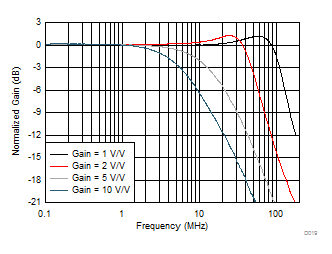 Figure 19. Noninverting Small-Signal Response vs Gain
Figure 19. Noninverting Small-Signal Response vs Gain  Figure 23. Noninverting Response Flatness vs Gain
Figure 23. Noninverting Response Flatness vs Gain  Figure 25. Noninverting Step Response vs VOPP
Figure 25. Noninverting Step Response vs VOPP 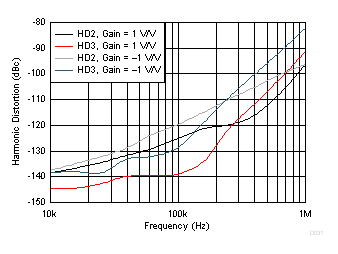 Figure 31. Harmonic Distortion vs Frequency
Figure 31. Harmonic Distortion vs Frequency  Figure 33. Harmonic Distortion vs Output Swing
Figure 33. Harmonic Distortion vs Output Swing 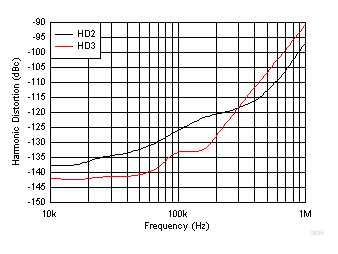
| See Figure 87, gain = 1 V/V, VOUT = 1 VPP, RLOAD = 2 kΩ | ||
 Figure 20. Inverting Small-Signal Response vs Gain
Figure 20. Inverting Small-Signal Response vs Gain 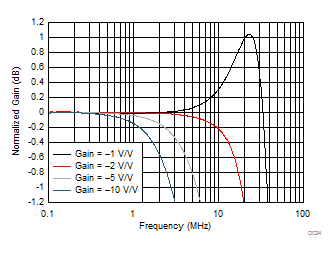 Figure 24. Inverting Response Flatness vs Gain
Figure 24. Inverting Response Flatness vs Gain  Figure 26. Inverting Step Response vs VOPP
Figure 26. Inverting Step Response vs VOPP 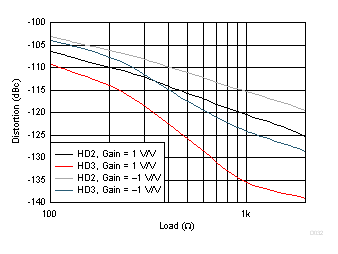 Figure 32. Harmonic Distortion vs RLOAD
Figure 32. Harmonic Distortion vs RLOAD  Figure 34. Harmonic Distortion vs Gain Magnitude
Figure 34. Harmonic Distortion vs Gain Magnitude 
| See Figure 88, gain of 1 V/V and 2 V/V, VOUT = 1 VPP,
RLOAD = 2 kΩ |

